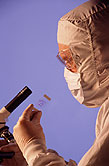
THURSDAY, Jan. 3 (HealthDay News) — More young women are following recently revised U.S. guidelines for getting Pap tests — the standard screening for cervical cancer — but many women who have had a total hysterectomy still get the tests unnecessarily, new government studies reveal.
Screening is not recommended until age 21, and the percentage of women between the ages of 18 and 21 who reported never being screened increased from about 24 percent in 2000 to nearly 48 percent in 2010, according to a report in the Jan. 3 issue of Morbidity and Mortality Weekly Report, a publication of the U.S. Centers for Disease Control and Prevention.
Although this is in keeping with the newer guidelines, another study found that about 60 percent of women get Pap tests even after having a total hysterectomy — a removal of the uterus and cervix. Most women don’t need screening after a total hysterectomy if the procedure was done for noncancerous reasons, according to the guidelines.
“As we monitor Pap test use among U.S. women, we can make sure that women are being screened in accordance with guidelines, to best maximize the benefits of screening and minimize the harms,” Meg Watson, an epidemiologist with the CDC’s Division of Cancer Prevention and Control, said in a CDC news release.
For a Pap smear, as it is also called, cells of the cervix are scraped off and examined for cancerous changes.
The new guidelines were issued last year by the U.S. Preventive Services Task Force, the American College of Obstetricians and Gynecologists and the American Cancer Society. The three groups recommend starting Pap tests at age 21 and then screening every three years rather than annually. They also said screening is unnecessary for women 65 years and older who have had several years of normal test results.
Keisha Houston, an epidemic intelligence service officer with CDC’s Division of Cancer Prevention Control, said the agency’s public health efforts are focused on women at highest risk. Cervical cancer is rare for women under age 21, which is why screening is not recommended for that age group, she explained.
“We need to remain vigilant and increase screening among women who would benefit most from this preventive service,” Houston added.
The studies, based on data from the CDC’s Behavior Risk Factor Surveillance System, also found the following:
- “Recent” Pap tests — meaning tests within the past three years — declined in women aged 30 and older who had not had hysterectomies. This was largely because Pap tests decreased in women 65 and older, from almost 74 percent in 2000 to about 65 percent in 2010.
- Almost 59 percent of women aged 30 and older who had their reproductive organs removed had a Pap test in 2010, down from more than 73 percent in 2000.
- Contrary to recommendations, 9 percent of women between the ages of 22 and 30 had not been screened, up from less than 7 percent in 2000.
- Among women aged 30 to 64, recommended Pap tests within the previous three years decreased among those lacking health insurance — to about 69 percent in 2010 from about 75 percent in 2000.
Under the Affordable Care Act, many women can obtain cervical cancer screenings through private health plans and Medicare with no co-pays or other out-of-pocket costs, the CDC noted.
More information
To learn more about the screening guidelines, visit the CDC’s cervical cancer screening guidelines chart.

